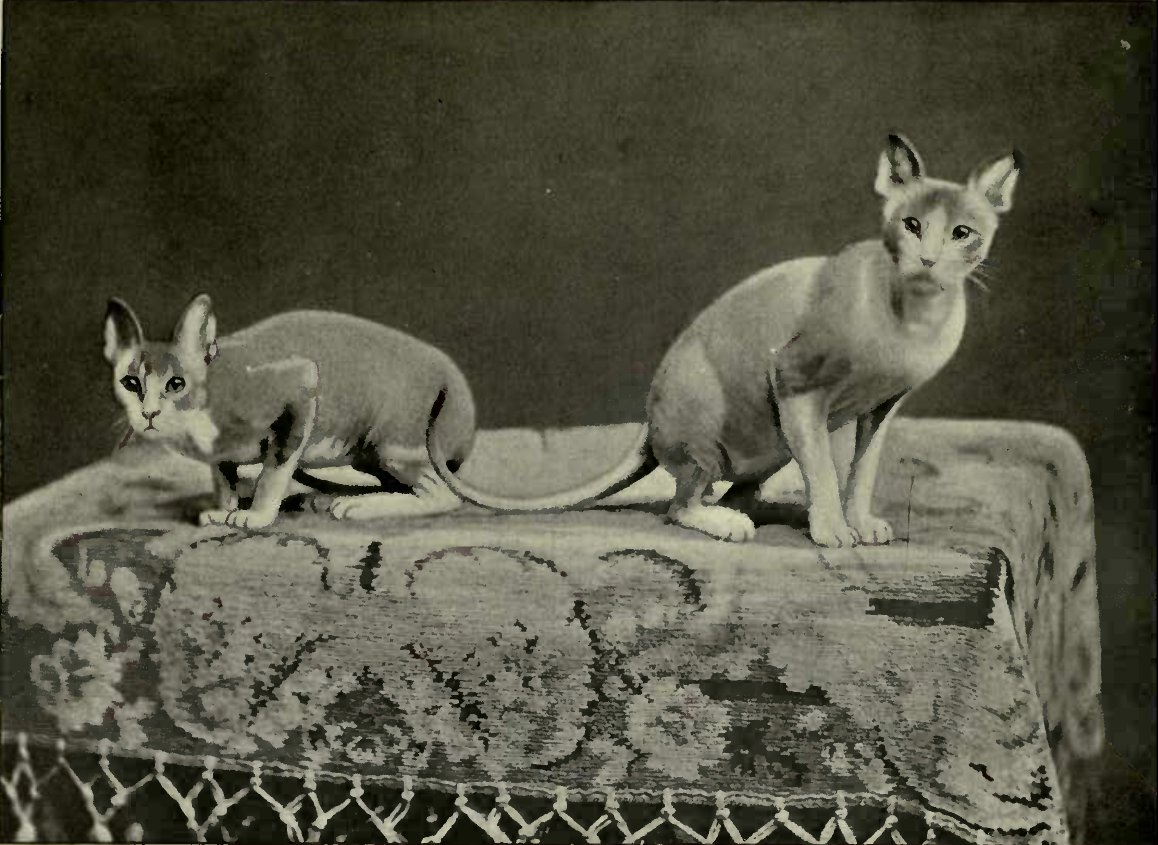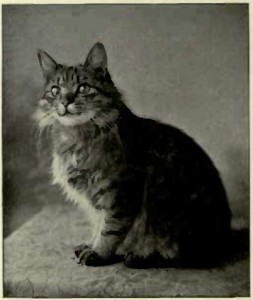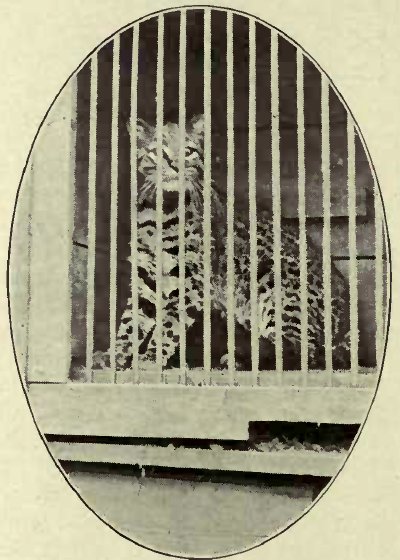XXVI. SOME FOREIGN CATS
Texte und Bilder aus “THE BOOK OF THE CAT” von Frances Simpson aus dem Jahre 1903
THE BOOK OF THE CAT
CHAPTER XXVI.
SOME FOREIGN CATS

IT is not intended in the following notes to enter into a description of the various beautiful and interesting wild felines, for although some of these—such as the Ocelot, the Geoffrey’s Cat, and the Wild Cat—are not infrequently seen in the pens at our leading shows, such matter really comes more within the province of a natural history than of the present work.
Two varieties alone may justly claim some slight attention here, these being the Egyptian cat (Felis maniculata] and the European wild cat (F. catus). It might reasonably be imagined that our common cat was derived from the last-named, considering that at one time it was a common animal all over England, as well as on the Continent. The untamable ferocity of this variety—which is probably the least amenable of all living creatures—has doubtless prevented its ever having been domesticated, and the high value which, as we learn from old writings, was placed upon the domestic puss at a time when the wild cat was a common animal in England, plainly show that F. catus was not the ancestor of jF. domestica, although the two will freely interbreed. Many years ago, for instance, the old Spanish wild cat which used to be kept at the Zoological Gardens in the so-called aviaries, now occupied by the civets, mated with his cage mate—a tortoiseshell-and-white queen—-and of these cross-bred kittens both Sir Claud Alexander and the writer of these lines possessed specimens.
It is usually assumed that the Egyptian or Caff re cat is the progenitor of the majority of the domestic cats. This is the variety which was domesticated, revered, and embalmed by the ancient Egyptians. It is found over the whole of Africa, and it is quite easy to understand how, with its eminently tamable disposition, it gradually spread over Europe. Our so-called Abyssinian cats, to which reference will be made later on, bear a very striking resemblance to this handsome variety of cat.
The domestic cats of other parts of the world, however, are undoubtedly derived from the smaller wild cats of the-countries in question. Thus it is probable that several varieties have a share in the creation of the Indian domestic cats, of which Blyth distinguished two varieties. The fulvous variety he considered to be derived from the Indian jungle cat (F. chaus), a fulvous cat which in its high legs, shorter tail, and slightly tufted ears— and it is worthy of note that some of the best Abyssinians have large and slightly tufted ears —marks the approach to the lyncine group. The spotted kinds he traces to the leopard cat, the desert cat, and the rusty-spotted cat.
A most extraordinary variety, of which next to nothing appears to be known, is the hairless cat, and we cannot do better than quote in extenso the description given by the owner of what, if his surmise should unhappily prove to be correct, was the last pair of these peculiar animals, a portrait of which we give.
Albuquerque, New Mexico,
February ^rd, 1902. MR. H. C. BROOKE.
Dear Sir,—Yours of January aoth is at hand. In answer would say my hairless cats are brother and sister. I got them from the Indians a few miles from this place. The old Jesuit Fathers tell me they are the last of the Aztec breed known only in New Mexico. I have found them the most intelligent and affectionate family pets I have ever met in the cat line ; they are the quickest inaction and smartest cats I have ever seen. They are fond of a warm bath, and love to sleep under the clothes at night with our little girl. They seem to understand nearly everything that is said to them ; but I have never had time to train them. They are marked exactly alike—with mouse-coloured backs ; with neck, stomach, and legs a, delicate flesh tint. Their bodies are always warm and soft as a child’s. They love to be fondled and caressed, and are very playful ; will run up and down your body and around your waist like a flash. “ Nellie “ weighs about eight pounds, and “ Dick „• weighed ten pounds ; but I am sorry to say we have lost “ Dick.“ We have never allowed them to go out of the house, as the dogs would be after them. They were very fond of our water spaniel, and would sleep with her, “ Dick „~was a sly rascal, and would steal out. One night last year he stole out, and the dogs finished him. His loss was very great, as I may never replace him. The Chicago Cat Club valued them at 1,000 dollars each. They were very anxious
for me to come on with them for their cat shows, but I could not go. They were never on exhibition ; as this is a small city, I feared they would be stolen. I have made every endeavour to get another mate for “ Nellie,“ but have not been successful. I never allowed them to mate, as they were brother and sister, and I thought it might alter “ Nellie’s “ beautiful form, which is round and handsome, with body rather long. In winter they have a light fur on back and ridge of tail, which falls off in warm weather. They stand the cold weather same as other cats. They are not like the hairless dogs, whose hide is solid and tough ; they are soft and delicate, with very loose skin. “ Nellie “ has a very small head, large amber eyes, extra long moustache and eyebrows ; her voice now is a good baritone, when young it sounded exactly like a child’s. They have great appetites, and are quite dainty eaters—fried chicken and good steak is their choice. Have never been sick an hour. The enclosed faded picture is the only one I have at present ; it is very lifelike, as it shows the wrinkles in its fine, soft skin. “ Dick “ was a very powerful cat ; could whip any dog alone ; his courage, no doubt, was the cause of his death. He always was the boss over our dogs; I have priced “ Nellie “ at 300 dollars. She is too valuable a pet for me to keep in a small town. Many wealthy ladies would value her at her weight in gold if they knew what a very rare pet she is. I think in your position she would be a very good investment to exhibit at cat shows and other select events, as she doubtless is the only hairless cat now known. I have written to Old Mexico and all over this country without finding another. I would like to have her in some large museum, where she would interest and be appreciated by thousands of people.—Trusting this will reach you in safety, I am, very truly yours, F. J. SHINICK.
We can only add, whilst deeply regretting that Mr. Shinick did not mate his cats, the earnest hope that we may hear that he has discovered the existence of other specimens. Should it prove that a parcel of street curs are responsible for this curious variety becoming extinct, even such confirmed dog lovers as ourselves are almost tempted to acquiesce in a universal and everlasting muzzling order ! It is to be regretted that no information is given as to whether the dentition of these cats was abnormal and imperfect, as is the case with the Mexican hairless dogs.
Very curious and handsome is the Indian cat “ Indischer Fiirst,“ exhibited by Mrs. H. C. Brooke. His most striking peculiarities are the length and slenderness of his limbs, the extreme shortness of his coat, and his thin and tapering tail, which reminds the observer of that of a pointer. His ears are small, but as a kitten they were of enormous size, and with his long and pointed head gave him a most weird appearance. The voice of this cat is very variable, and far more resembles the raucous call of the Siamese than the voice of any European cat.

This cat has had a very adventurous existence. He, with his litter sister, was originally stolen from a hotel in Bombay by an English sailor. On the way home he twice fell overboard, but, more fortunate than his companion, was safely rescued. He also suffered shipwreck in the Sobraon on Yung Yung Island. On arriving nearer home he disappeared, and was only after several days‘ absence discovered in the bowels of the ship, as black as the coal amongst which he had been sojourning. His last exploit was to fall in the docks, after which the sailor handed him over to a shoemaker at Leytonstone, where he was discovered by his present owner. After he had twice escaped from bondage and astonished the natives of that place by perambulating the housetops, lamenting in the tones of a lost soul, his owner arrived at the conclusion that he had no convenience for restraining him, and at last yielded to persuasion, and handed him over to his present proprietors for consideration of sundry gold coins of the realm and a kitten with seven toes on each foot.

It is a very remarkable thing that the Asiatic cats are so subject to abnormal formations of the tail. The Siamese cats, as is well known, very frequently possess kinked tails. In Burma also cats are found—some tail-less, some with crooked or twisted stumps. These cats, when spotted, are very striking ; when of an ordinary colour they simply recall an indifferent Manx.
Japan also possesses tail-less cats ; but those with ordinary caudal appendages also occur, and are probably the most numerous. There is said to be a variety of Chinese cat which is remarkable for its pendent ears. We have never been able to ascertain anything definite with regard to this variety. Some years back a class was provided for them at a certain Continental cat show, and we went across in the hope of seeing and, if possible, acquiring some specimens ; but, alas, the class was empty ! We have seen a stuffed specimen in a Continental museum, which was a half-long-haired cat, the ears being pendent down the sides of the head instead of erect; but do not attach much value to this.
We have seen specimens of a very tiny domestic cat, full-grown individuals of which weigh only about three pounds. Those we saw came from South America.
A cat called the Mombassa cat, from the East of Africa, is said to have a short coat of a wiry texture. There are, of course, no cats indigenous to Australia. An American writer gives it as his opinion that a certain strain of Australian cats is derived from imported Siamese cats. A specimen we possessed last year, which was born on a ship during the passage from Australia, and which exactly resembled its dam, certainly had every appearance of being of Eastern origin. It had the marten-shaped head, and a triple kink in the tail ; its voice also resembled that of the Siamese. In colour it was grey, with darker spots.

A very taking variety is the Abyssinian. A good specimen should very strongly resemble what one might well expect the Egyptian cat to become after generations of domestication. Since the death of “ Sedgemere Bottle “ and “ Sedgemere Peaty “ there have been no cats penned of such superlative merit as were these two specimens. The photograph of“ Sedgemere Peaty“ which we give hardly does justice to the cat. The colour of an Abyssinian should be a sort of reddish-fawn, each individual hair being “ ticked “ like that of a wild rabbit—hence the popular name of “ bunny cat.“ The great difficulty in breeding these cats is their tendency to come too dark and too heavily striped on the limbs ; the face should be rather long, the tail short and thick, and the ears large. These points are well shown by “ Little Bunny Teedle Tit,“ first in the Abyssinian class at the 1902 Crystal Palace cat show, though in colour she was not the best penned. The Abyssinian should not be a large, coarse cat. A small cat of delicate colouring and with the above-mentioned body properties is by far to be preferred to the large, coarse, dark specimens one sees winning under some all-round judges, merely because of their size.

More than any other varieties have the foreign cats suffered from the negligence of show committees and the awful judging of all-round judges, plus the equally awful reports furnished by all-round reporters ! At the best, knowledge of the different varieties of foreign cats is absolutely in its infancy. It should be the aim of large shows to provide, whenever possible, judges for these interesting strangers who do really take some interest in them. I am bound to say that of late years the National Cat Club has done its best to meet the wishes of owners in this respect, and with gratifying results, as witness the good classes at the Crystal Palace show, where there were no fewer than eleven Abyssinians penned — a record number !
The Cat Club, on the other hand, has persistently neglected them, having on almost every occasion handed them over to some all-round judge who knows little and cares less about them, with the natural result that exhibitors are disgusted. Take, for instance, the last show, when a very dark, almost sooty Abyssinian was placed above a very fair specimen merely because the latter had about a dozen white hairs on its throat ! The value of the winner may be gauged from the fact that its owner, a lady well known in the cat world, expressed her intention of having him neutered and keeping him merely as a pet. The same judge, in dividing the prizes amongst the Manx cats, appeared to think the colour of the throat of far more importance than the shape of the hindquarters in this section. Again, of what value does the reporter flatter himself his writings can be when we read in a so-called critique of a spotted Geoffrey’s cat and of an ocelot that they are “ pretty tiger-marked specimens “ ? We wonder if the gentleman ever saw a tiger.
There is much that is fascinating—much, nay almost all—to learn, the most beautiful colours
and arrangements of markings to be studied, by those who will devote their attention to foreign cats. To the search for something new we owe the beautiful Siamese. Will no one pay some attention to the other varieties of the feline tribe from distant lands ? They are well worth it, and the addition of more foreign cats at our shows would be interesting and instructive.
H. C. BROOKE.

